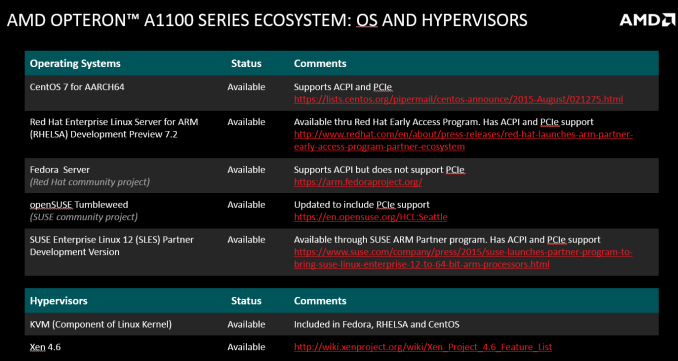The Silver Lining of the Late AMD Opteron A1100 Arrival
by Johan De Gelas on January 14, 2016 1:19 PM EST- Posted in
- Cloud Computing
- AMD
- Arm
- Opteron
- Opteron A1100
Feature Rich
But not all servers are compute limited. Quite a lot of server tasks are I/O limited. Think static webserving, reverse proxys (Varnish server), in memory key value stores (Memcached), all kind of network servers and "cold" storage servers.
| Low End Server SoCs: feature comparison | |||
| Feature | Opteron A1100 | Atom C2000 | Xeon-D |
| Max. RAM Capacity | 4 x 32 GB RDIMM | 4x 16 GB RDIMM | 4 x 32 GB RDIMM |
| PCIe | 8 gen 3.0 lanes | 16 gen 2.0 lanes | 24 gen 3.0 lanes 8 gen 2.0 lanes |
| SATA | 14x SATA3 | 2x SATA3 4xSATA2 |
6x SATA3 |
| Ethernet | Dual 10 Gb | Dual 1 Gb | Dual 10 Gb |
| USB | Not Integrated | 4x USB 2.0 | 4x USB 3.0 4x USB 2.0 |
With 14 SATA ports and two real 10 Gb Ethernet ports, AMD's A1100 is a great place to start to build a storage device. Considering that quite a few storage devices now use a quadcore A15, which is limited to 4 GB of RAM (16 GB with PAE tricks), an octal core A57 that can address 128 GB opens up new opportunities. The quad core A1120 will do nicely even though it might consume up to twice as much (25W) as Annapunra Labs Alpina AL5140 SoC (Quad A15 at 1.7 GHz), which needs around 10W. In a storage device with 16 disks, 10W should not be a deal breaker, especially if you can offer more caching, faster encryption and higher overall performance.
The specs do not look bad for a caching server either, as 32 GB RDIMMs are less expensive per GB than 8 GB RDIMMs now.
Software Support, or Why it Took So Long
The other big question is of course why A1100 took so long. The answer to that is actually pretty simple. Some of the building blocks like fine tuned ACPI and PCI Express support for ARM CPUs were not initially adapted to the server world, and AMD needed to wait for those to come along to give A1100 a fighting chance.
Just look at the slide with software support and see the comment "supports ACPI and PCIe". That would look pretty odd on an announcement of an x86 server CPU, but it is relatively new for a 64 bit ARM server environment. You might ask yourself how our Applied X-Gene server worked well with Ubuntu server nine months ago. The X-Gene server ran a specially adapted version of Ubuntu. That is fine as a temporary solution, but unless the modifications go "mainstream linux", each new version must be adapted again to make it work with your server. Costly and time consuming, so AMD went the other way, making sure that the necessary improvements were part of the official Linux kernel.
For the Ubuntu fans: the A1100 runs on top of ubuntu 15.10. According to AMD, it is fully functional but at the moment without support of Canonical.











37 Comments
View All Comments
Lonyo - Thursday, January 14, 2016 - link
In terms of manufacturing and performance, since Samsung recently inked to fab some Qualcomm systems, and GloFo/Samsung have a partnership, is there not potential for a somewhat rapid improvement in process to use an advanced, up and running and potentially available capacity 16nm process from Samsung within a short period of time? (<18 mo) to bring them closer to the new Atoms that are due.Kevin G - Thursday, January 14, 2016 - link
In 18 months we should be looking at the arrival of AMD's K12 chip if all goes according to plan.nandnandnand - Thursday, January 14, 2016 - link
K12 is expected to be on a 14/16nm process, right?medi03 - Friday, January 15, 2016 - link
Most likely 14nm (Samsung's process, with GloFo on board)Jtaylor1986 - Thursday, January 14, 2016 - link
Why did you ever both to write this article? I hope 2 pages of bashing AMD got whatever grievance you had out of your system. I will look forward to more professional articles in the future.Lonyo - Thursday, January 14, 2016 - link
I could 1 page of bashing AMD for being late and non-competitive in raw number terms. Then 2 pages of explaining potential use cases.Lonyo - Thursday, January 14, 2016 - link
*Count.Jtaylor1986 - Thursday, January 14, 2016 - link
Begs the question why cover it at all if this is a totally uncompetitive product that is effectively dead on arrival. Why spend resources covering a product nobody will ever buy when there are numerous products lots of people buy they haven't covered.eanazag - Thursday, January 14, 2016 - link
Cover it because it is finally done. Plus 14 SATA 3 connectors and dual 10 GigE is nothing to scoff at. Add to that a good size of DDR4 ECC RAM and we have something to think about. I suggest you price shop dual 10 GigE for less than $400 and see what you get. I think those items make it worth considering despite the proc being uncompetitive on several fronts. Don't be confused; this is a niche system. This is not a jack of all trades setup.beginner99 - Friday, January 15, 2016 - link
Still even for real use (business) or just for myself for fiddling around I would go with the Xeon-D. It's just so much more powerful. Yes it costs more but not much. Even if its $500 vs.$ 1000. Software you run on that will cost 10x times of that amount.